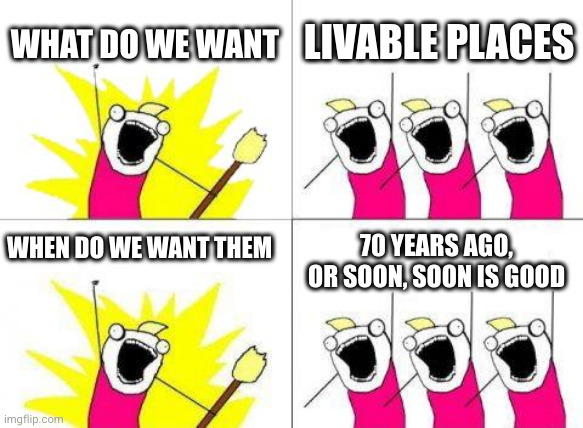What Urbanists Want

Housing Reform
Most zoning and other home building regulations in the United States are highly restrictive. These laws largely make it illegal to build anything other than single family homes in most areas of most of the US and intentionally relegate more affordable styles of housing to far away areas and beside noisy highways with poor air quality and little options to go outside.
Urbanists seek to reform these laws so that more varied types of housing can be built in more locations. While results will vary depending on the type of reform, in general these types of reforms can result in more affordable housing, walkable and friendly neighborhoods, and more diversity of income within a single neighborhood.
Big picture these reforms seek to make a neighborhood more like a neighborhood and less like a series of large expensive pods where neighbors can’t easily interact.
To put it another way, these reforms seek to be big tent where if someone wants to live in a single family house they certainly can but they do not get to say that their neighborhood should exclude young adults, service workers, or first responders on the basis of income.
Today many cottages, townhouses, apartment buildings, condos, and other housing get relegated to specially designated areas. Any amenities they have, such as a park, or local walkable grocery, are cut off by distance and roads from the rest of the town or city.
Housing reform is all about sharing a vibrant neighborhood with your neighbors rather than cutting out your own tiny and uninteresting sliver.
Good Transportation
Urbanism takes the realistic stance that a car dependent society has been a significant failure in many aspects of life, from smog and health, to loneliness and isolation, to thousands of hours wasted in traffic, to 40,000 yearly traffic fatalities and 2,500,000 injuries. Someone you know, care about, or love will be seriously injured or killed on a road at some point in your life. It is a statistical inevitability. Many times when this happens we will blame the driver, or call it an “accident” but the true cause of this unnecessary suffering is undoubtedly car dependence.
While cars are still necessary urbanism seeks to reform our car dependent society and shift to multi-modal transportation which reduces our need for cars. This includes making space and improvements for bus lanes, bike lanes, trains, walking, and hoverboards once science catches up. Many of our towns and cities today are hostile to non-car transportation. Lacking shade, sidewalks, and safe street crossings they are wholly unfit for most people most of the time.
Urbanism also seeks to make things safer and faster for cars, manual laborers, and emergency vehicles. By getting drivers off the road when they don’t need to be our roads become less occupied with cars and reduce traffic. With less cars on the road maintenance is also reduced and the occurrence of potholes and need to repave roads becomes less frequent.
Much like housing, the urbanist approach to road safety is also big tent. Some people will need to use roads for their job or for particularly remote travel or just because they like driving on open roads every so often. That’s perfectly fine but we must make our roads less crowded and safer.
Human Scale Neighborhoods
Most US neighborhoods are built at car scale rather than human scale. They prioritize placing housing separate from spaces such as parks, groceries, restaurants, and all other types of places where people like to gather. They create long travel distances for the types of things that replenish everything from your fridge to your soul.
Human scale neighborhoods seek to bring these necessities of life closer to where people live. Allowing people to easily bump into their neighbors. To get that missing ingredient they need for tonight’s dinner. Or hop on a bus to and from a restaurant without worrying about parking, expensive taxis. Closer amenities make our roads less busy, reduce our climate impact, and drop drunk driving rates.
Fairness
Our cities unfortunately have a history of unfair treatment depending on who you are and where you live. These issues are many and vast, some of the most salient of which are:
- Redlining: The wholesale exclusion of racial and ethnic minority neighborhoods from financial services such as home loans.
- Segregation by design: How local governments through policy and actions forced our cities and neighborhoods to be segregated. Such as the destruction of Black American and immigrant neighborhoods to build highways as physical barriers separating former neighbors.
- Zoning: The habit of wealthy neighbors to advocate for moving whatever they don’t want to less fortunate neighborhoods.
Urbanists seek to address these issues by supporting laws, projects, and protests that address a wide variety of equity concerns.